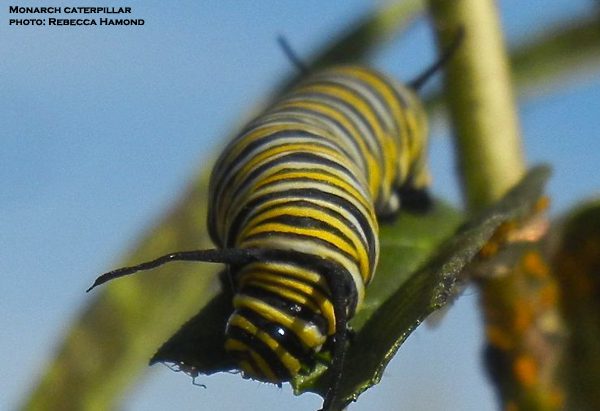 Plant Milkweed for Monarchs
Plant Milkweed for Monarchs  Says New Ferndale Group
Says New Ferndale Group
(Rebecca Hammond, April 12, 2015)
About five years ago, my husband and I headed to the UP after the Mackinac Bridge Walk. The Bridge Walk is spectacular and a must-do Michigan event, but added to the experience was the gentle cloud of  Monarch butterflies heading south along with tens of thousands of us walkers. Afterwards we drove west along US 2 and kept seeing Monarchs, a sparse but nonstop parade, all beginning a journey of as much as three thousand miles.
Monarch butterflies heading south along with tens of thousands of us walkers. Afterwards we drove west along US 2 and kept seeing Monarchs, a sparse but nonstop parade, all beginning a journey of as much as three thousand miles.
Since then the number of monarchs has dwindled alarmingly, with a list of reasons: climate change and extreme weather including storms, droughts, and heat waves, and summers of wildfires. Deforestation in Mexico is a factor. Pesticides and GMO crops are contributing to the drop in population, as is loss of habitat and especially a great reduction in amounts of the only plant monarchs use as a host: milkweed.
This we can do something about, and in Ferndale we are.
The Ferndale Monarch Project intends, over time, to turn our inner-ring suburb into a monarch haven, adding as many  butterfly gardens as we can. A butterfly garden can be as few as two plants: one milkweed, one nectar plant. Monarchs lay eggs only on milkweed, an egg hatching into a caterpillar that lives about two weeks before forming a chrysalis from which a butterfly emerges in another two weeks or so. This can happen four times a summer, the last butterflies of the season being the only ones that head south.
butterfly gardens as we can. A butterfly garden can be as few as two plants: one milkweed, one nectar plant. Monarchs lay eggs only on milkweed, an egg hatching into a caterpillar that lives about two weeks before forming a chrysalis from which a butterfly emerges in another two weeks or so. This can happen four times a summer, the last butterflies of the season being the only ones that head south.
There are numerous native varieties of nectar plants, including Ferndale’s official city flower, the purple coneflower. Western Market of Ferndale is teaming up with the Monarch Project to provide both plant types. Bee balm and butterfly weed are two other good choices. These plants will benefit bees and birds as well, and will attract hummingbirds and even hummingbird moths. Watch for those at twilight.
Where would we like to see these gardens? Wherever they fit. Our DPW will plant some in parks. That leaves schoolyards, church grounds, maybe parking islands, and our own yards. Ronda Spink of the Michigan Butterfly Network in Kalamazoo told me, “If you plant it, they will come.” We’re hoping that anyone connected with an organization or business with open space will plant some of that space for the butterflies. Renaissance Vineyard Church is the first house of worship to join the effort. The upcoming native-plants pilot project near City Hall will include milkweeds and nectar plants.
would we like to see these gardens? Wherever they fit. Our DPW will plant some in parks. That leaves schoolyards, church grounds, maybe parking islands, and our own yards. Ronda Spink of the Michigan Butterfly Network in Kalamazoo told me, “If you plant it, they will come.” We’re hoping that anyone connected with an organization or business with open space will plant some of that space for the butterflies. Renaissance Vineyard Church is the first house of worship to join the effort. The upcoming native-plants pilot project near City Hall will include milkweeds and nectar plants.
Want to get directly involved, find links to butterfly sites, ask questions? Or just meet some other butterfly enthusiasts? Search for Ferndale Monarch Project on Facebook.
The response so far has been tremendous.

